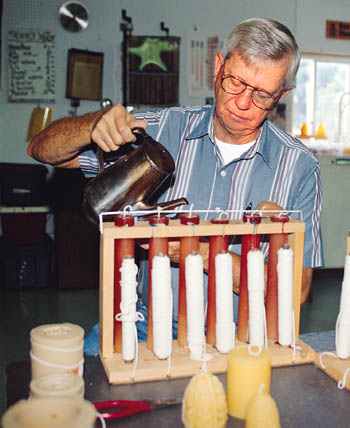Beekeeper Molds By-Product Into Profitable Business

Since retiring from Chrysler Corp. a few years ago, Madison County beekeeper Bill Mullins has been burning the candle at both ends.Not only does he produce about 12,000 pounds of honey each year, but he also raises queen bees and represents his industry statewide as chairman of the Alabama Farmers Federation’s Bee and Honey Committee.With all of that to keep him occupied, you’d think Mullins would be content to relax after the fall honey harvest, but that’s not the case for this “busy bee.”Thanks to a business he started 10 years ago at the prompting of his daughter-in-law, Debi, Mullins is hard at work this time of year melting, purifying and molding beeswax into decorative candles, Christmas ornaments and fragrant potpourri. It’s work he describes as both therapeutic and rewarding.”It keeps you busy, and helps take your mind off other things,” Mullins said. “It makes you feel good to create different shapes, colors and fragrances of candles.”Mullins, who sells his candles to gift shops and at craft fairs in Alabama and Tennessee, said beeswax candles have been made for more than 5,000 years and have distinct advantages over traditional paraffin candles.”Beeswax is not petroleum based, so it doesn’t produce as much smoke. And, beeswax candles burn longer and have a naturally sweet aroma,” he said.
For Mullins, the candle-making process begins when he harvests honey. The frames containing the honeycomb are placed in a device that slices the top layer (or cap) from each hexagonal honey cell. The frames are then placed in a centrifuge that extracts the honey, which is later bottled in pints, half-pints and quarts. The waxy caps are collected, melted and filtered several times to produce bricks of pure beeswax.When Mullins is ready to make candles, the bricks are melted, and the wax is poured into molds. Many of his products maintain the original golden color and sweet smell of the beeswax, but Mullins also can add one of 24 fragrances to his creations or dye the wax to produce a rainbow of colors.But changing the color of beeswax, Mullins admits, is not as easy as one might think.”Beeswax is a primary color (yellow), so when you add dye to it, you don’t always get the color you want. It took us a while to find a dye that would work,” he said.Over the years, Mullins has perfected the process and now teaches others how to make beeswax candles at classes sponsored by the Huntsville-Madison County Botanical Garden. As for his own business, Mullins figures he makes about 3,000-4,000 candles a year, including 1,000 votives and 1,000 tapers.He also makes pillar candles, decorative candle eggs and a variety of seasonal shapes, like pumpkins, corn and poinsettias. Potpourri is made by pouring scented beeswax into candy molds, and natural-colored Christmas ornaments are rubbed with a brownish-gold powder to give them an antique look. Mullins also sells blocks of beeswax to customers who use it on everything from saw blades to quilting thread. In all, Mullins makes about 20 different kinds of candles–often using tools and equipment he designed especially for his craft. But the Meridianville beekeeper does not consider himself an artist. Rather, he said Debi and his wife, Sue, are his “creative directors.”Mullins said their decorative flair is showcased in gift baskets created for customers. Each is different, but most include a variety of candles, at least one jar of honey and a handful of honey candy.With the Mullins women finding new ways to market candles, Bill decided to print a catalog, which will be released this month. Meanwhile, the increased demand for his candles has forced him to look beyond his own hives for wax.Mullins explained that each honey frame yields about a half an ounce of beeswax. That equates to about 4-5 ounces per super or not more than 15 ounces per hive. Each taper or votive candle contains 1.5-2 ounces of wax, and a large pillar candle can weigh as much as 13 ounces.Mullins said he tries to get about $1 for each ounce of beeswax in a candle, which means his tapers sell for about $1.50. Comparable candles fetch as much as $3 in some specialty shops.EDITOR’S NOTE: For more information about beeswax candles, contact Mullins at Bill’s Honey Farm, (256) 828-4836.
